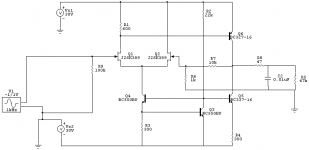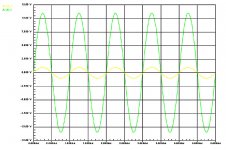Actually though, I find that degree of adjustability most useful for subwoofers, being that they usually need some equalization also.
Also, one man's lower midrange (or midbass) is another man's subwoofer. Not only can I not afford a 21" driver, if I do put it in my appt I am sure the whole building will come crashing down. Not that I can afford XVR1 as well, but I can dream of building the high/low pass one day
You can sum the outputs and drive a single subwoofer....
And how would you do that
You can sum the outputs and drive a single subwoofer....
And how would you do that?
Read the Shiva white paper and got my answer
Hi all.
This is my first post on this BB (since i only found it about an hour ago ) - i reached the BB b/c i am a DIYer and been working, for the past year, on a 3way speaker project - the project makes use of some of the best drivers available (Lambda TD10S, PHL 1340 and a Seas millenium tweeter if it interests you) and i'm planning on runing it Bi-amped - hence, i am digging up info on active XO's and found the XVR1 VERY interesting (an understatement
) - i reached the BB b/c i am a DIYer and been working, for the past year, on a 3way speaker project - the project makes use of some of the best drivers available (Lambda TD10S, PHL 1340 and a Seas millenium tweeter if it interests you) and i'm planning on runing it Bi-amped - hence, i am digging up info on active XO's and found the XVR1 VERY interesting (an understatement  ).
).
I have a question though, and i am well aware it is a possibly stupid one - is this XVR1 a preamp too? I mean, does the user feed the XO' directly through the source and from there to the power amps? Or does it still need a preamp (before or after the unit)?
If so, then why doesn't it have a master volume control or something like that?
In any case - seems like this is a great BB - so, if you don't mind, i'll stick around
Many thanks in advance,
Guy.
This is my first post on this BB (since i only found it about an hour ago
I have a question though, and i am well aware it is a possibly stupid one - is this XVR1 a preamp too? I mean, does the user feed the XO' directly through the source and from there to the power amps? Or does it still need a preamp (before or after the unit)?
If so, then why doesn't it have a master volume control or something like that?
In any case - seems like this is a great BB - so, if you don't mind, i'll stick around
Many thanks in advance,
Guy.
Well, you can use it for gain, and if you turn all 4 knobs
I was wondering about that myself. How about using a passive pre at the input? Since I only listen to CDs anyhow that should be all I need.
Input impedance
66 Kohm balanced differential, 44 Kohm single ended
Gain, input to output
Low Q, XLR = 5.6 dB, RCA out = -.4 dB
Med Q, 6/12 dB/oct, XLR = 8.6 dB, RCA out = 2.6 dB
Med Q, 18/24 dB/oct, XLR = 13.4 dB, RCA out = 7.4 dB
Hi Q, 6/12 dB/oct, XLR = 11.6 dB, RCA out = 5.6 dB
Hi Q, 18/24 dB/oct, XLR = 17.6 dB, RCA out = 11.6 dB
Not bad at all. Now, the question is: will the high/low pass sport similar specs?
66 Kohm balanced differential, 44 Kohm single ended
Gain, input to output
Low Q, XLR = 5.6 dB, RCA out = -.4 dB
Med Q, 6/12 dB/oct, XLR = 8.6 dB, RCA out = 2.6 dB
Med Q, 18/24 dB/oct, XLR = 13.4 dB, RCA out = 7.4 dB
Hi Q, 6/12 dB/oct, XLR = 11.6 dB, RCA out = 5.6 dB
Hi Q, 18/24 dB/oct, XLR = 17.6 dB, RCA out = 11.6 dB
Not bad at all. Now, the question is: will the high/low pass sport similar specs?
Hello Mr. Pass.
How do you think the XVR1 will function with an active preamp?
I bet it will depend on the active pre's gain..., but you see, i have an active tube based DIY preamp - it's current gain is 5:1 (it's transformer coupled) and i thought about changing the trranies for ones with higher turn ratio (for other reasons as well) that would eventually yield a gain of 1.5:1 - will working such a pre into the XO' cause any problems in your opinion? Will it be best to feed the XO' with a passive pre?
Anyway - i too am waiting eagerly to seeing your DIY version of an active crossover!
Keep up the good work - this forum is the best i know so far!
Cheers,
Guy.
How do you think the XVR1 will function with an active preamp?
I bet it will depend on the active pre's gain..., but you see, i have an active tube based DIY preamp - it's current gain is 5:1 (it's transformer coupled) and i thought about changing the trranies for ones with higher turn ratio (for other reasons as well) that would eventually yield a gain of 1.5:1 - will working such a pre into the XO' cause any problems in your opinion? Will it be best to feed the XO' with a passive pre?
Anyway - i too am waiting eagerly to seeing your DIY version of an active crossover!
Keep up the good work - this forum is the best i know so far!
Cheers,
Guy.
has anybody built the discrete single ended Class a gain stages?
I would like ot use this circuit as an opamp. How much would the resistors be?
The current source would be 100 Ohm for 6ma bias in the input pair. I guess that would be at least 200 ohm for the output stage.
The resistor to +Vcc would be around 4-5 Kohm so there is a dc of around 1/2 +Vcc when Vcc is 30 Volts. There is also one more resistor which I think sets the gain. What would this resistor be?
Is the real circuit more complex or so simple?
I would like ot use this circuit as an opamp. How much would the resistors be?
The current source would be 100 Ohm for 6ma bias in the input pair. I guess that would be at least 200 ohm for the output stage.
The resistor to +Vcc would be around 4-5 Kohm so there is a dc of around 1/2 +Vcc when Vcc is 30 Volts. There is also one more resistor which I think sets the gain. What would this resistor be?
Is the real circuit more complex or so simple?
I've built similar circuits with stuff I've got on hand (mostly Motorola and Fairchild) with excellent results. Currently, Nelson is prone to using the Zetex parts for bipolars, so it's very likely that you're looking at 450s and 550s there. The dual JFET will be the 2SK389. The front end bias will be something on the order of 5 mA, plus or minus a few. The output and its associated current source will most likely be a bit higher, perhaps as much as 10 mA. The resistor values will pretty much fall into place once you select rail voltages. Shoot for 15-30V, looking to keep the voltage across the '389 around 15V. Though most op amps have truly scary amounts of gain, Nelson's circuit is going to be quite low in that regard. You'll need to decide how much gain you need for your system before you start assigning R values for the front end load. I'd say that it's likely that most of the gain is coming from the output stage (in Nelson's circuit--you may want more), hence indicating fairly low values for the JFET load resistors.
Grey
Grey
well for the input pair it can only be 2SK389.
the either resistor I refered to is not for gain but connect the +Vcc to the bases of the 2 current sources I think so the third transitor can turn on. How much would this resitor be? I guess so much as so the voltage across this transistor is 1,2 Volts with a bias of 3ma. 60-1,2 = 58,8 Volts. 58,8/3ma =20 Kohm.
the either resistor I refered to is not for gain but connect the +Vcc to the bases of the 2 current sources I think so the third transitor can turn on. How much would this resitor be? I guess so much as so the voltage across this transistor is 1,2 Volts with a bias of 3ma. 60-1,2 = 58,8 Volts. 58,8/3ma =20 Kohm.
OK, folks, I have set up a Wiki for those who are interested to get some pcbs, so that we understand demand and quantity and costs of boards better:
http://www.diyaudio.com/wiki/index.php?page=MOX+
I would like to encourage you to signal your demand for the boards, so that we understand better about what business we are talking. As a couple of questions are still open (final board design, who will actually manage the distribution and money collecting etc), this is not an order yet, so don't ask for price etc, just help to understand the demand.
Best Regards
http://www.diyaudio.com/wiki/index.php?page=MOX+
I would like to encourage you to signal your demand for the boards, so that we understand better about what business we are talking. As a couple of questions are still open (final board design, who will actually manage the distribution and money collecting etc), this is not an order yet, so don't ask for price etc, just help to understand the demand.
Best Regards
XVR1 connection
I read the question a little differently, so I will chime in here. This is not a substitute for a volume control. You will still need a volume control to work your system well.
Normal connection is that you place the XVR1 between your pre-amp or volume control. There are 2 outputs for each channel, one for the bass, one for the treble. You connect them to the appropriate amplifier.
in example, I have the Pass XP20 line stage. It drives the XVR1 crossover at the volume I want. The XVR1 is connected to a Pass Labs XA30.5 to control my bass speakers, and also is connected to a First Watt J2 for midrange and treble.
Hope that answers your question OA.
I read the question a little differently, so I will chime in here. This is not a substitute for a volume control. You will still need a volume control to work your system well.
Normal connection is that you place the XVR1 between your pre-amp or volume control. There are 2 outputs for each channel, one for the bass, one for the treble. You connect them to the appropriate amplifier.
in example, I have the Pass XP20 line stage. It drives the XVR1 crossover at the volume I want. The XVR1 is connected to a Pass Labs XA30.5 to control my bass speakers, and also is connected to a First Watt J2 for midrange and treble.
Hope that answers your question OA.
- Home
- Amplifiers
- Pass Labs
- Pass Labs XVR1 crossover

